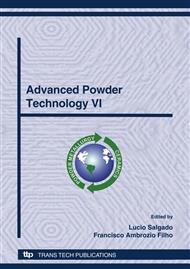p.791
p.799
p.805
p.811
p.816
p.821
p.827
p.833
p.839
Study and Optimization of Reaction of Hydration of Calcium Oxide to Produce Slaked Lime Suspension
Abstract:
Slaked lime is a suspension of hydrated lime in water that can contain up to 40% of solids in suspension. The quality of the suspensions of slaked lime depends on the quality of lime used and on a careful choice of the conditions during the hydration process. A high quality slaked lime is a product with a small quantity of insoluble residues, high specific surface area, high alkaline content and small particle size. Therefore, the objective of this work was to study the best conditions of temperature and concentration to produce a superior slaked lime. A statistic analysis was performed using the experimental results in order to optimize the operational conditions of the hydration process. The use of hydration water around 74 °C, of small particles of CaO (0.144 mm) and of a CaO/H2O ratio around 220 g/L contributed to the production a slaked lime suspension of fine quality.
Info:
Periodical:
Pages:
816-820
Citation:
Online since:
August 2008
Keywords:
Price:
Сopyright:
© 2008 Trans Tech Publications Ltd. All Rights Reserved
Share:
Citation:


